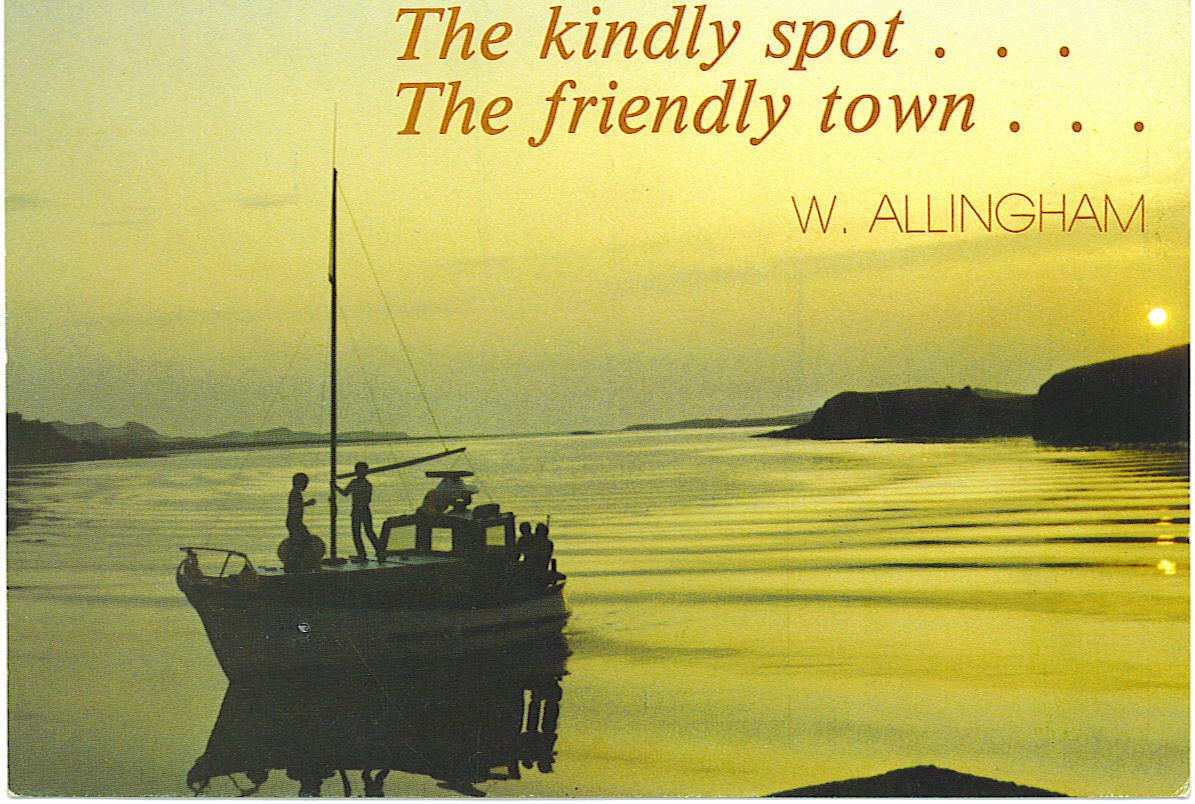The Mall Quay and Erne Estuary, where countless people left Ballyshannon en route to the USA and Canada
Should auld acquaintance be forgot
And never brought to mind?
Should auld acquaintance be forgot
And the days of auld lang syne?
Nowadays as people sing Auld Lang Syne on New Year’s Eve it is worth remembering that this was an emigrant song, which was regularly played or sung at the Mall Quay in Ballyshannon 200 years ago. Relatives and friends of people emigrating by ship, from Ballyshannon to places like Canada and America, gathered on the quay and along the shoreline, to wave goodbye to people they might never see again.
An eyewitness account of a ship called The Mayflower which was sailing to America from the Mall Quay in 1827 was recorded by a Ballyshannon woman called Mary Anne Allingham. She was an aunt of the poet William Allingham. Her family were engaged in importing timber from Norway to Ballyshannon and her writings were uncovered in a library in Trondheim in Norway by a music researcher Eva Hov.
The Mayflower was owned by a Ballyshannon business man James McGowan of West Port in the town. Mary Anne Allingham described the sadness of those emigrating to the poignant strains of Auld Lang Syne and the sadness of those gathered along the shoreline to bid farewell.
She recorded as follows: “On the 11th July 1827 the Mayflower a passenger ship for America fell down the bay to Coolnarget and took in the emigrants, the evening was lovely, the scene beautiful - yet sad, the parting of friends, who perhaps will never meet again, is a melancholy sight, the bitter yet repressed sobs of one - the loud and wild screams of another fall on the heart with a sensation not to be described.
"When the last boat reaches the ship, some musicians who had gone as a convoy to their friends so far, began to play the touching air of Auld Lang Syne with an effect felt by every heart, and never to be forgotten by me: many a passenger ship I have seen since unfurl its sail for the New World, but none made such an impression on my heart as this.”
It is interesting to note that ships anchored in the deeper water near Coolnarget sandhills which are still visible from the Mall Quay today, and passengers were carried by boat out to the ship.
James Mc Gowan, the owner of The Mayflower, was a businessman who resided in West Port in Ballyshannon. He was a well- known importer in the 1820s who imported and sold metal ware, iron, iron hoops, tin, tar, oak staves, earthenware, crockery, coal, timber and slates. By 1827 his business had prospered and he had expanded into passenger ships for which there was a growing demand.
The Mayflower was a brig which regularly sailed between Ballyshannon and St Johns New Brunswick and Quebec carrying passengers on the outward journey and timber on the homeward journey
Captain's Letter
In the summer of 1833 the journey to Quebec took 29 days and the Captain, Mr Reid, in a letter to James Mc Gowan, recorded a stormy sea journey from Ballyshannon and the quarantining / detention of passengers in Quebec:
Quebec 20th June 1833
Sir, I take this opportunity to inform you of our safe arrival after a passage of 29 days, to the quarantine ground, where in consequence of the good health and clean appearance of the passengers we were released after 24 hours detention. I am now landing the passengers. I never experienced such severe weather as on this passage, indeed the Mayflower astonished me by her well doing,
I am dear Sir,
Yours etc.
H. Reid
The Parting Hour
The maiden voyage of The Mayflower which had left the harbour at Ballyshannon, on the 11th July 1827 was also recorded in verse by Mary Anne Allingham in her poem called The Parting Hour .The following is an extract from the poem describing what she witnessed from the Mall Quay:
Every hill is covered over
With a group of weeping friends
Sister, brother, friend and lover
Every tie sad sorrow rends.
Each one to the vessel turning,
Seems in distance to retrace:
Those dear friends for whom they’re mourning,
Each beloved and well known face.
Hush! ‘tis Music! Sweetly stealing
Oh! how thrilling is the strain.
Cold the heart-devoid of feeling
If not touched with love, and pain.
Hush! ‘tis Music! Softly playing
Auld Lang Synes, heart stirring lay.
“Tho’ seas between us roar” `tis saying
“Forget not Auld Lang Synes blithe day”

We can picture friends and relatives on the surrounding headlands, such as Dungravenan, and down along the shore, bidding a sad farewell to their friends and family members whom they may never have seen again.
For auld lang syne, my dear
For auld lang syne
We’ll drink a cup of kindness yet
For the sake of auld lang syne
Subscribe or register today to discover more from DonegalLive.ie
Buy the e-paper of the Donegal Democrat, Donegal People's Press, Donegal Post and Inish Times here for instant access to Donegal's premier news titles.
Keep up with the latest news from Donegal with our daily newsletter featuring the most important stories of the day delivered to your inbox every evening at 5pm.